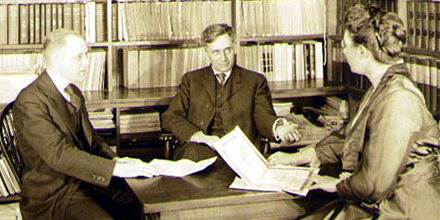Paper shows story of legal heroes solving crisis of 1929 stock market crash was a myth
LAWRENCE — Origin stories are powerful. From the Book of Genesis to Peter Parker’s fateful encounter with a radioactive spider, people draw a special kind of meaning and identity from these “founding” narratives. In the world of corporate finance, the birth of mandatory disclosure looms especially large: In the years after the stock market crash of 1929, Franklin D. Roosevelt brought a team of Ivy League lawyers down to D.C. to help rein in Wall Street; the mandatory corporate disclosure system they invented has provided the foundation of government regulation of business ever since.
Just one problem: That’s not what happened.
Alex Platt, associate professor of law at KU, has a new paper uncovering what he calls the “lost history” of mandatory disclosure. While conventional accounts focus on the drafting and enactment of securities laws by FDR’s team of legal eagles, Platt’s “revisionist history” looks past the law on the books to the details of how the system was actually implemented. He found that the real administration of mandatory disclosure in the 1930s departed from and even contradicted the law.
Many know the names Franklin Roosevelt, Louis Brandeis, Felix Frankfurter and James Landis. But Baldwin Bane? Not so much. According to Platt, though, this obscure civil servant played a critical role in the founding of securities regulation and deserves broader recognition.

In July 1933, with the new securities law set to take effect, Bane was in charge of administering it. Companies for the first time had to file a disclosure document with the government 20 days before selling stock to the public. If the disclosure had “material” deficiencies, the government could block the stock sale by filing an administrative enforcement action before the window closed.
When this carefully crafted statutory system was finally set to be implemented, Bane found himself in a quandary. On the very first day, Bane and his small staff received about a hundred separate disclosure filings. And, upon review, all of the filings were materially deficient.
Bane knew that pursuing formal enforcement actions against all 100 companies (as the statute directed) was infeasible, given his small staff. So he came up with a workable alternative: He told his staff to write letters to all of the companies, advising them of the problems the staff identified, inviting amendments and threatening formal action in the event of noncompliance.
This “deficiency letter” system took off; going forward, virtually all companies filing disclosures received one or more of these letters – and virtually none received the formal enforcement actions contemplated by the law. The effect, Platt said, was nothing less than transformative.
For instance, because of delays built into the back-and-forth of the letter-writing process, the vast majority of stock offerings were delayed far beyond the 20 days contemplated by the statute. And instead of the government conducting only a “preliminary review” of disclosures for obvious problems as Congress had envisioned, the agency conducted what it described as a “careful and critical” analysis of every statement.
Bane invented the system and oversaw its implementation for several decades as a civil servant. To this day, companies looking to go public must go through the same deficiency letter process that Bane invented 90 years ago.
Platt told the story in a newly released paper, also forthcoming in the Journal of Corporation Law. Platt first encountered deficiency letters as a practicing lawyer and started looking into the history of the system while he was teaching at Harvard Law School. Over time, Platt pulled together sources from many archival collections, including those at Harvard University, Columbia University, the Franklin D. Roosevelt Presidential Library, Washington & Lee (Bane’s alma matter) and others.
“Early on, I realized there was something essential that was missing from the standard version of the origin story. Everyone has a picture in their mind about how this all started, and the picture just isn’t correct,” Platt said. “Brandeis, Frankfurter, Landis and other elite lawyer intellectuals tend to get all the credit. Bane was a humble civil servant, but he had a tremendous effect.”
Bane's decision to abandon the statutory system also changed the essential character of the regime. The statute had been drafted by acolytes of Brandeis and reflected his regulatory philosophy: The government would maintain an adversarial relationship with business, making rules and suing those who violated them, with an emphasis on transparency. Bane’s system, by contrast, created a cozier interdependent relationship between government and business, effectively inviting elite securities professionals into the regulatory process.
“By drawing these accountants, lawyers and bankers into the regulation structure, Bane moved this system away from the pure Brandeisian model and closer to the rival corporatist model,” Platt said. “Under Bane’s system, it’s really government and industry working together to produce these disclosures.”
The paper, which was recently featured on the Harvard Law School Forum on Corporate Governance, calls on readers to reconsider and think critically about history. Platt said that policymakers like current SEC Chair Gary Gensler frequently call back to the origins of the regime in the 1930s to explain or justify current actions.
“If people are using the origin story to try to legitimize something they are doing today, what does it mean if we find out the origin story they are pointing us to is really more of an origin myth?” Platt said.
Image: Louis Brandeis, center, is pictured in his office. Brandeis is often credited with shaping the philosophy at the center of legislation that solved the problems leading to the crash of 1929 and Great Depression. Credit: WikiCommons.